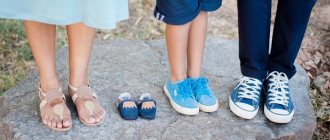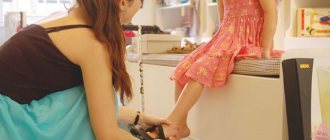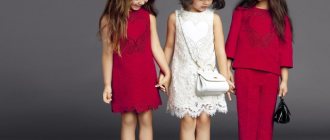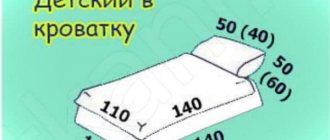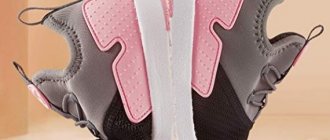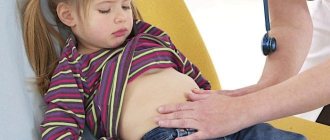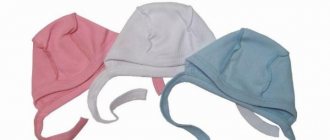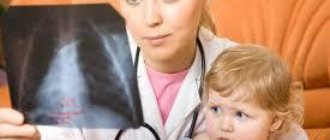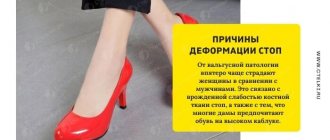08 October 2018
Averyanova Sveta
There are usually no problems with choosing shoes in a store with a child. Shoes are tried on until a pair that fits the feet is found. But if a mother wants to order shoes or sneakers through an online store or chooses a gift without the possibility of trying on, she will need a size chart of shoes for children. How not to make a mistake when buying shoes, choose the ideal option based on foot length and fullness, and choose the size of winter shoes in the summer, we will tell you in our article.
How to determine a child's shoe size
Shoe sizes for children are determined by foot length and fullness. They need to be measured at home. To obtain accurate data you will need a piece of paper, a pencil and a ruler. To determine your shoe size by foot length, follow the following algorithm:
- First place the baby's right foot on the paper.
- Trace around with a pencil, pressing the lead firmly against the arch of your foot.
- Repeat the procedure with the left leg.
- Take a ruler.
- Using the resulting outline, measure the distance between the center of the heel and the tip of the big toe.
- Correlate the data obtained with the accepted system for determining the size of boots of the country of origin. The children's foot size chart will come to your aid.
- Remember to consider the fullness of the leg. Wide shoes are not suitable for thin feet. It is better to take one with laces, a lock, and for a full one - with Velcro to regulate the free space.
How to measure your child's overall foot length
The first thing you need to do when choosing boots, shoes, boots or sandals for your baby is to measure his feet. It is recommended to carry out this procedure in the evening, at this time of day the ankle is most “trampled” and enlarged by 5-8%.
To take measurements you must do the following:
- place the baby on a piece of paper so that its weight is evenly distributed;
- trace the outlines with a felt-tip pen or pencil;
- measure the distance from the middle of the heel to the tip of the big toe with a ruler on both legs. If their length is different, you should focus on those numbers that are larger;
- It is worth adding 1-1.5 cm to the results obtained. You can also check the gap with the little finger of an adult. It should pass freely near the backdrop.
In addition, there are several nuances that should be remembered when taking measurements. If the baby is too small, you can find out the necessary parameters using a thread or rope. It is recommended to determine the child’s shoe size for closed models by measuring the foot in socks.
Useful tips
- In children aged 1 to 3 years, the foot grows quickly. Measure your feet every three months.
- For infants, take measurements in a sitting position, lying down with a tape measure; for older children - standing.
- The data will be accurate in the evening, when the foot increases from daytime load and slight swelling.
- For winter shoes, take measurements with socks on, for summer shoes - barefoot.
- Be sure to set the length of both feet. Right and left indicators may differ. This is the norm. But when buying boots, focus on feet that have larger sizes.
- Add 0.5–1 cm to the resulting length for infants and children under 3 years old, 0.5 cm for teenagers. The extra space inside the boots is necessary for ventilation. This advice does not need to be taken into account when buying beach shoes with open toes and heels.
- Round the received data up to normal. If it turns out to be 16.2 cm, focus on the length of 16.5 cm, that is, Russian size 26. And if the foot is 15.1 cm, then round up to 15.5 cm, which means you need shoe size 25.
Important! Adult children only need to calculate the size while standing. In this position, the body weight puts pressure on the leg, it increases by several millimeters or even 1 cm.
We also recommend that you watch this detailed video:
A little anatomy
Children's feet, as a rule, are actively developing until the age of eight. Until the age of eight, a child’s foot consists only of fragile muscles, developing tendons and adipose tissue. To prevent abnormal development of the baby’s feet (flat feet, hallux valgus or varus deformity, etc.), it is extremely important to choose the right children’s shoes, taking into account all the structural features of children’s feet. When choosing shoes for a child under eight years old, pay attention to ensuring that new sandals or boots do not dangle on the foot, but also do not squeeze it. Excessive compression can deform a child's fragile foot, and shoes that are too loose can contribute to the development of flat feet, so maintaining balance is extremely important.
Orthopedists also recommend paying attention to orthopedic insoles for children and adults. They will allow you to wear your favorite shoes in comfort.
Remember, the younger the child’s age, the more actively his feet develop, so it is very important to measure the length of the baby’s feet in a timely manner. This will help you replace your old pair of shoes with a new one in time. Thus, measurements of a child’s foot must be carried out:
- Up to three years: once every 2-3 months;
- From three to seven years: once every 4-5 months.
Over the course of a year, a two-year-old baby can change a couple of shoe sizes, and preschoolers’ foot sizes increase by two sizes every year. In school-age children, every year the leg grows by one, maximum two sizes.
The shoes became tight. How to understand?
Usually children themselves signal to their parents that the shoes are no longer the right size. This is manifested by a clear reluctance to put on sneakers or sandals that fit perfectly a week ago. You will also notice that now the child has difficulty placing his feet in previously familiar shoes. This is the first sign that it's time to buy new boots. However, you should not completely trust the child in this case, since at an early age the child’s foot is covered with a fatty layer, which reduces the pain threshold of sensitivity, which means that your baby himself may not realize that the shoes have become tight, and meanwhile the foot will deform smoothly.
Parents need to examine their baby’s feet as often as possible to identify redness, abrasions, calluses, and whether he curls his toes while walking. Tight shoes can be signaled by their heels, which begin to hang over the heel, and its upper part becomes very tight. The big toe in tight shoes ends up quite close to the edge (fifteen millimeters or closer).
Sizing system in different countries
Children's shoes are produced all over the world, and size markings vary from country to country. This must be taken into account when purchasing boots of foreign and Russian production. Let's look at this in more detail:
- In Russia, Europe, China, and CIS countries, the system is metric.
The basis is the length of the foot in millimeters. The size chart for these manufacturers is the same. The interval between values is 0.5 cm, which is very convenient. For example, if size 24 is close and size 25 is too big, then you can always buy 24.5. - In England, feet are measured in inches. 1 inch is equal to 2.54 cm. English shoes begin the size range from 0, then increase by 1/3 inch.
- France uses a stichmass system based on the stiches. 1 piece = 2/3 cm. The manufacturer measures not the foot, but the insole.
- In America, sizes can be determined by foot length, but in inches. The mesh shift is 1/12 inch, or 2.1 mm.
One is not like the other
It should be noted that different manufacturers may have different sizing charts. Therefore, when choosing children's shoes, parents need to pay attention to this. You can also read reviews from moms and dads about manufactured products.
Certain models are characterized by some professional nuances that influence the choice of size.
To figure out what shoe size to buy for a child at 12 cm, you need to know that some of the shoes produced by this company are designed only for narrow feet. And a certain part of the models runs about a size small compared to the size chart. This mainly applies to winter boots, because the manufacturer initially intended the difference between the length of the baby’s foot and the insole to be only 5 mm. For warm boots this is very little, because it also means wearing warm socks. This is very important to consider when choosing.
So, in shoes from this company, a foot length of 12 cm corresponds to size 19.5. But, based on the above, when choosing shoes for a cold autumn or winter, you should probably buy size 21, at which the foot length is 13 cm.
Another company producing children's shoes is Viking. Moreover, this is one of the small number of manufacturers whose size correspondence after fitting differs significantly from that indicated in the table on the official website. Therefore, if parents decide to purchase shoes (the advice here applies more to shoes and boots) from this company without trying them on or through an online store, you should not completely trust the size chart: the size of the models deviates greatly from what is stated.
Based on reviews, we can conclude that a significant number of pairs of this brand are oversized. Based on this, it is immediately difficult to figure out what size a child’s shoes are with a 12 cm foot. With such a foot length, the size should be 19.5.
Table for children by age
Shoe sizes for children by age are determined only approximately, but for orientation in stores and when ordering online, you can also use this table of ratios (Important! The table can be scrolled right and left on mobile devices):
| Child's age (girl) | Child's age (boy) | Foot length, cm (options) | Shoe size (Europe, Russia, China) |
| From 3 to 6 months | From 3 to 6 months | 9,5 | 16 |
| 10 | 16,5 | ||
| 10,5 | 17 | ||
| 6 to 9 months | 6 to 9 months | 11 | 18 |
| 11,5 | 19 | ||
| 9 to 12 months | 9 to 12 months | 12 | 19,5 |
| 12,5 | 20 | ||
| From a year to a year and a half | From a year to a year and a half | 13 | 21 |
| 13,5 | 22 | ||
| 2–3 years | 14 | 22,5 | |
| 1.5–2 years | 14,5 | 23 | |
| 15 | 24 | ||
| 2–3 years | 15,5 | 25 | |
| 4–5 years | 16 | 25,5 | |
| 16,5 | 26 | ||
| 3–4 years | 17 | 27 | |
| 4–5 years | 5–6 years | 17,5 | 28 |
| 18 | 28,5 | ||
| 5–6 years | 18,5 | 29 | |
| 6–8 years | 19 | 30 | |
| 19,5 | 31 | ||
| 6–7 years | 20 | 31,5 | |
| 20,5 | 32 | ||
| 8–12 years | 21 | 33 | |
| 21,5-22 | 34 | ||
| 22,5 | 35 | ||
| 23 | 36 |
Important! As can be seen from the table, girls' feet grow more slowly and are naturally smaller than boys' feet. Therefore, you also need to pay attention to gender and age.
Size chart by foot length
The easiest way to select shoes is based on foot measurements taken at home in cm or mm. To simplify the translation of the size chart depending on the country of origin of the shoes, use the tables.
Size chart for children under one year old
| Foot length, cm | Russia/Europe | USA | Great Britain |
| 8,3 | 16 | 0,5 | 0 |
| 8,9 | 16 | 1 | 0,5 |
| 9,2 | 17 | 1,5 | 1 |
| 9,5 | 17 | 2 | 1 |
| 10,2 | 18 | 2,5 | 1,5 |
| 10,5 | 18 | 3 | 2 |
| 10,8 | 19 | 3,5 | 2,5 |
| 11,4 | 19 | 4 | 3 |
| 11,7 | 20 | 4,5 | 3,5 |
| 12,1 | 20 | 5 | 4 |
Table for children from 1 year to 5 years
| Foot length, cm | Russia/Europe | USA | Great Britain |
| 12,7 | 21 | 5,5 | 4,5 |
| 13 | 22 | 6 | 5 |
| 13,3 | 22 | 6,5 | 5,5 |
| 14 | 23 | 7 | 6 |
| 14,3 | 23 | 7,5 | 6,5 |
| 14,6 | 24 | 8 | 7 |
| 15,2 | 25 | 8,5 | 7,5 |
| 15,6 | 25 | 9 | 8 |
| 15,9 | 26 | 9,5 | 8,5 |
| 16,5 | 27 | 10 | 9 |
| 16,8 | 27 | 10,5 | 9,5 |
| 17,1 | 28 | 11 | 10 |
| 17,8 | 29 | 11,5 | 10,5 |
| 18,1 | 30 | 12 | 11 |
How to measure
In order to determine the fullness of the leg, it is necessary to measure its girth at the most protruding points (bones). This procedure is best done in the evening, when the leg is at its maximum size, using a flexible measuring tape.
In Russia, this indicator is designated by numbers 1-12, the interval between them is 4 mm. For European brands it is indicated by numbers 1-8 in increments of 5 mm. In the USA, as well as the UK, the letter designations A, B, C, D, F are used with a difference of 5 mm. In addition, English-speaking manufacturers have 5 decreasing values (2A, 3A, 4A, 5A, 6A) and 5 increasing ones (2F, 3F, 4F, 5F, 6F).
To calculate according to the Russian system, the girth is multiplied by 0.25 and the length by 0.15. After this, the second result and the coefficient corresponding to age are subtracted from the first result. The resulting value is rounded up.
| Foot in cm | Completeness | Coefficient | |
| Booties | 9.5-12.5 | 1 | 20.0 |
| Nursery | 10.5-14.0 | 1-3 | 16.5 |
| Malodetskaya | 14.5-16 | 1-5 | 16.5 |
| Preschool | 17.0-20.0 | 1-5 | 16.5 |
| School | 20.5-24 | 1-8 | 13.5 |
| Maiden | 22.5-26 | 1-8 | 16 |
| Boy's room | 24.5-28 | 1-8 | 16.2 |
How to choose the size of shoes for a child
Many parents are interested in how to measure the fullness of a child’s feet, but unfortunately, this is not always useful, since not all manufacturers of children’s shoes take into account and indicate the width of the shoes on their models. And this indicator is very important. Sandals, shoes and sneakers of the same size (for example, size 17) may be too tight or too loose for your baby.
It all depends on the fullness of the leg.
In European countries, the letters C, D, E and others are indicated next to the size on the sole or on a special label. What do they mean? This is a criterion for the narrowness and width of the boots. You can decipher them like this:
- C – the narrowest shoes possible, for very, very thin feet.
- D – slightly wider than C. For very thin feet.
- E – shoes for narrow feet.
- F – average width.
- G – width slightly above average.
- N – wide shoes.
Important! If there are no markings for narrowness and width, then it is suitable for the average foot.
The completeness of the leg can be obtained in numbers and this data can be used to order through online resources. Use the formula:
P (fullness of the foot) = 0.25 O (circumference of the foot at the widest point) – 0.15 D ( length of the foot from heel to toes) – 16.5
This is interesting! According
to the results of a study of the shoe market,
American shoes are usually wider than Chinese, European and Russian ones. This is due to national physiological characteristics.
Classification of children's shoe sizes
The size of a child’s feet in centimeters by age is calculated according to international systems adopted in each country:
- Metric (Russia).
- Shtikhmassovaya (Europe).
- Inch (America and Great Britain).
To correctly determine the size of a child’s feet, you need to know the length of the foot and its width. This will help you choose the appropriate pair of shoes. These results are divided into 2 types of sizes: by fullness and by length .
The child's foot length is the basic measurement for choosing shoes. It is calculated by the distance from the heel to the beginning of the foot. The size of the fullness of the shoe is determined by the circumference of the foot at the widest point.
In Russia, this parameter has a numeric code from 1 to 12:
- 1 – up to a year;
- 1-3 – up to 3 years;
- 1-5 – 3-7 years;
- 1-8 – 8-12 years;
- 1-12 – from 12 years old.
Fullness is calculated using the formula: (Foot circumference in mm*0.25) – (Foot length in mm*0.15) – 17.
The resulting number is rounded up and corresponds to the fullness of the shoe.
In European countries, completeness is indicated by a code from 1 to 17. English completeness is determined by Latin letters from A to F with additional designations of narrowness (2A-6A) and width (2F-6F).
In America they use the literal meaning:
- N – narrow;
- M – average;
- X – wide;
- XW – very wide.
How to choose your first shoes
Proper footwear for newborn babies and children under 1.5 years old must meet certain standards:
- The boots have two or three fasteners to secure the foot. For newborns and infants, choose Velcro to adjust the width of the internal cavity depending on the thickness of the sock you are wearing.
- A rigid high heel, even for summer sandals, is a must.
- Round toe without points or bulges. This is convenient and safe for a toddler who is just learning to walk.
- In any pair of shoes, leave a margin of 0.5 to 1 cm for freedom of the toes.
- You can't take shoes to grow into. For example, if a child needs size 20, then size 22 is too much. This makes walking difficult and the baby loses balance.
- Find out the size of your child's feet while lying down as an infant, recheck every three months.
- Consider the rise of your feet. For infants, do not buy boots that are too high.
- Take the weather outside into account. Infants do not need to take warm boots for a warm spring. It is more convenient for them to run in sneakers or leather shoes with low sides.
Important! You can't wear shoes all the time. Be sure to take your child off his shoes at home so he can walk barefoot on hard floors, sand and earth. This is a good massage and prevention of flat feet.
What should be the length reserve for children's shoes?
Having extra length in shoes for children is essential. The supply is needed not at all in order to choose a pair for a child to grow into, but for comfortable wearing of shoes. To determine the reserve distance, add from 0.6 to 1 cm to the length of the foot along the insole, depending on the season.
So for sandals and sandals there will be enough margin of 6-8 mm, for sneakers and sneakers – 8-10 mm. Winter shoes require a margin of 10-15 mm to be able to put on socks without losing comfort.
Such a large margin is necessary to ensure that the leg is positioned correctly when walking from a physiological point of view. During movement, the size of the foot can increase by up to 0.7 cm. Having space in the shoe gives room to push and eliminates pressure, bending of the toes, providing comfort and room for growth.
In addition, do not forget about the fullness of the shoes. Full legs require an increase in stock by 2-3 mm, while thin feet require narrower models.
How to tell if shoes are too small
Finding out that boots or closed shoes are too small is difficult if the child does not speak yet, cannot complain about tightness in the fingers, or pain when walking. In this case, the mother needs to act like this:
- After going outside, carefully examine your baby's feet. If there are red spots on the heel or toes, or pain is felt, then it’s time to change the shoes.
- Put your child's shoes on and press the toe in the big toe area with your hands.
There should be some space left. If the tops are suitable in width and size, there will be free space and your finger will not rest on the edge. - Inspect the boots. A stretched surface and bubbles on the backs indicate tightness. Inspection of shoes should be done regularly, since a child’s feet grow quite quickly after a year.
- Find out if there is any free space between the foot and the tongue.
Try putting your finger under the tongue. If it doesn't fit, change your shoes. They are not the right size or fullness.
How to check the size in closed models
Choosing sandals for the summer, as a rule, does not cause problems. In such models it is immediately clear how small or large they are. A particular difficulty is choosing shoes for the winter and off-season. Here you can make sure that boots or boots are selected according to the anatomical features of the foot in the following ways:
1. Using paper and pencil. Trace the outline of the foot, placing the baby on a thick sheet of paper or cardboard. Hold the pencil perpendicular to the floor. Cut out the resulting outline and insert it into the shoes. Insert your fingers and check whether the outline has taken up all the space or whether there is free space left in it.
2. Using an insole. If possible, remove the insole from your boots or shoes and place it on your baby's foot.
3. Using your thumb. Put your child in shoes, sneakers or boots, and then press the edge with your thumb. This will help you understand whether there is free space left inside and how big it is.
What material to choose shoes from?
Shoe material is very important for young children. What to look for when choosing boots made from different raw materials:
- The material must be breathable. In rubber boots, your feet sweat, but in leather shoes and textile sneakers, the skin breathes and does not overheat.
- Hypoallergenic. This is an indicator of quality. Leather, latex, felt, suede are suitable for allergy sufferers. Low-quality rubber and natural felt can cause unpleasant reactions.
- Smell. Smell the shoes, sneakers. If they smell unpleasant, repulsive, then you shouldn’t buy them.
- Rigidity. Textile shoes wear out quickly, the fabric bubbles and becomes deformed. This negatively affects the formation of the ankle. Shoes made of genuine leather are worn, maintaining their appearance for a long time, without causing harm to the gait and foot of the child.
An approximate list of models and materials is given in the table (Important! The table can be scrolled right and left on mobile devices):
| Material | Advantages and disadvantages | Models | What time of year is it suitable for? |
| Genuine Leather | • Does not get wet • Does not deform • Breathes • Long lasting • Looks aesthetically pleasing • Safe for babies • High price | Shoes, boots, shoes, sneakers, sandals | All year round |
| Eco leather | • Cheap • Beautiful • Wears out in one season | Shoes, sandals | Summer |
| Suede | • Natural material • Easily deformed • Gets wet • Worn out from wear | Spring, autumn boots, shoes | Cold summer, early autumn and spring |
| Lightweight fabric (jeans, linen, cotton) | • Lightweight shoes • Breathable material • Low price • Hypoallergenic material • Not recommended for two-year-old children and infants for long-term wear | Sneakers, slippers | Summer, late spring |
| Dense warm material (felt, felt) | • Keeps out the cold • Easy to wear for babies • Breathable • Waterproof | Felt boots, warm boots | Winter |
| Rubber, latex | • Wear-resistant • Waterproof • Does not heat feet | Boots, flip flops, beach shoes, sandals | Autumn, summer |
Size charts of common brands
Fans of global brands will find it useful to use tables of correspondence between Russian shoe sizes, manufacturer markings and foot length. All that remains is to try on your feet and buy the shoes you need from the catalog through the online store.
AliExpress (“Aliexpress”)
On this trading platform, the size corresponds to the foot length of a child and an adult. That is, how many centimeters is the leg, buy that size. A very convenient system for Russian consumers.
| Foot length, cm | 9,5 | 10 | 10,5 | 11 | 11,5 | 12 | 12,5 | 13 | 13,5 |
| Size on the seller's website | 9,5 | 10 | 10,5 | 11 | 11,5 | 12 | 12,5 | 13 | 13,5 |
"Kotofey"
Not too expensive children's shoes for all seasons are made from natural high-quality materials. The manufacturer produces boots and sandals for children of any age. Products are divided into groups by age.
"Kapika"
This brand is responsible for shoes in the off-season and cold weather. "Kapika" offers a wide selection of rubber boots, dutik, galoshes. Choose your size according to the grid. It is the same for “Kotofey”.
| Age group | |||||||||
| Booties | Foot length, cm | 9,5 | 10 | 10,5 | 11 | 11,5 | 12 | 12,5 | |
| Shoe size | 16 | 16,5 | 17 | 18 | 19 | 19,5 | 20 | ||
| From 1 year to 3 years (nursery) | Foot length, cm | 10,5 | 11 | 11,5 | 12 | 12,5 | 13 | 13,5 | 14 |
| Shoe size | 17 | 18 | 19 | 19,5 | 20 | 21 | 22 | 22,5 | |
| Young children From 3 to 6 years | Foot length, cm | 14,5 | 15 | 15,5 | 16,5 | ||||
| Shoe size | 23 | 24 | 25 | 25,5 | 26 | ||||
| Preschool | Foot length, cm | 17 | 17,5 | 18 | 18,5 | 19 | 19,5 | 20 | |
| Shoe size | 27 | 28 | 28,5 | 29 | 30 | 31 | 31,5 | ||
| School (from 7 to 10–12 years) | Foot length, cm | 20,5 | 21 | 21,5 | 22 | 22,5 | 23 | 23,5 | 24 |
| Shoe size | 32 | 33 | 34 | 34,5 | 35 | 36 | 37 | 37,5 | |
| Teenage | Foot length, cm | 24,5 | 25 | 25,5 | 26 | 26,5 | 27 | 27,5 | 28 |
| Shoe size | 38 | 39 | 40 | 40,5 | 41 | 42 | 43 | 43,5 |
Adidas (“Adidas”)
Produces high quality sports and casual shoes. You can choose a model for children by correlating the length of the foot and the usual leg sizes with the English measure. For example, according to the table, European size 32 corresponds to English size 13.5.
| Age group | Foot length, cm | Size (Russia, Europe) | Size (UK) |
| From 1 year to 3 years | 11,4 | 19 | 3K |
| 12,2 | 20 | 4K | |
| 13,1 | 21 | 5K | |
| 13,6 | 22 | 5.5K | |
| 13,9 | 23 | 6K | |
| 14,6 | 24 | 7K | |
| 15,1 | 25 | 7.5K | |
| 15,9 | 26 | 8.5K | |
| 16,9 | 27 | 9.5K | |
| From 4 to 8 years | 17,1 | 28 | 10K |
| 18,3 | 29 | 11K | |
| 18,5 | 30 | 11.5K | |
| 19,1 | 31 | 12.5K | |
| 20 | 32 | 13,5 | |
| 20,6 | 33 | 1 | |
| 21,1 | 34 | 2 | |
| 21,6 | 35 | 2,5 | |
| From 9 to 12 years | 22,7 | — | 3 |
| 23 | 35 | 3,5 | |
| 23,3 | 35,5 | 4 | |
| 23,9 | 36 | 4,5 | |
| 24,3 | 36,5 | 5 | |
| 24,9 | 37 | 5,5 | |
| 25,2 | 38 | 6 | |
| 25,9 | 38,5 | 6,5 |
Nike
The manufacturer successfully combines price and quality of goods. That's why it's so popular with customers. Use the table to select your shoe size.
| Age | Foot length, cm | 8,3 | 9,1 | 10 | 10,8 | 11,6 | 12,5 | 13,3 | 14,2 | 15 | 15,9 | 16,7 | 17,2 | 17,6 | 18 | 18,4 | 18,8 | 19,3 | 19,7 |
| Children | Size, Russia | 14 | 15 | 16 | 17,5 | 18,5 | 20 | 21 | 22,5 | 24 | 25 | 26 | 26,5 | 27 | 27,5 | 28,5 | 29 | 30 | 30,5 |
| US size | 0C | 1C | 2C | 3C | 4C | 5C | 6C | 7C | 8C | 9C | 10C | 10.5C | 11C | 11.5C | 12C | 12.5C | 13C | 13.5C | |
| Teenagers | Length, feet, cm | 20,1 | 20,4 | 20,8 | 21,2 | 21,6 | 21,9 | 22,3 | 22,7 | 23,1 | 23,4 | 23,8 | 24,2 | 24,6 | |||||
| Size, Russia | 32 | 33 | 33,5 | 34 | 35 | 35,5 | 36 | 36,5 | 37,5 | 38 | 38,5 | 39 | 40 | ||||||
| Size, England | 13,5 | 1 | 1,5 | 2 | 2,5 | 3 | 3,5 | 4 | 4,5 | 5 | 5,5 | 6 | 6 |
"Fairy tale"
Produces comfortable shoes and boots for boys and girls from 0 to 12 years. The largest size is 30.
| Insole length, cm | 9,5 | 10 | 10,5 | 11 | 11,5 | 12,5 | 13 | 13,5 | 14,5 | 15 | 15,5 | 16,5 | 17 | 17,5 | 18 | 19 |
| Size | 16 | 16,5 | 17 | 18 | 19 | 20 | 21 | 22 | 23 | 24 | 25 | 26 | 27 | 28 | 29 | 30 |
The right stock, or shoes for growth
The costs of producing a high-quality pair of children's shoes are almost equal to the costs of producing adult ones. Therefore, many parents have an understandable desire to save money by buying larger shoes for their child.
Why you shouldn't buy shoes to grow
Shoes that are too large will make it uncomfortable and difficult for a child to move. In such a product, the position of the toe and heel is not fixed. The baby will shuffle his feet, get tired quickly, fall, and twist his legs.
Shoes too big for a child
The arch support is the main element of today's popular orthopedic models. Wearing shoes with arch supports by a child creates conditions for the correct formation of the arch of the foot. The main thing is the physiologically correct location of the instep support. It is located clearly under the heel notch on the foot. Moving this part forward, backward or to the side turns a useful shoe into one that can cause serious impairment.
What happens when wearing shoes bought for growth? The child's foot turns out to be shorter than the insole of the sole, so the arch support moves forward. And the larger the shoe is compared to the child’s foot, the more the instep support moves from the right place to the toes. As a result of incorrect leg position, the child redistributes the load on the outer part of the foot, and clubfoot appears. Afterwards, curvature begins in the ankle joint, and possibly in the hip joint.
There is a possibility that the child will first be forced to wear bulky shoes, and by the next season his feet will grow so large that the shoes will be too small for him to grow. And here, alas, you won’t be able to save money. Therefore, do not create difficulties for yourself and your baby - choose shoes according to your foot size.
Recommendations from orthopedists on choosing the size of children's shoes
Orthopedists strongly recommend that when buying shoes for a child, add to the length of the foot:
- Physiological allowance. It is approximately 5 mm. This free space inside the shoe is necessary for the free position of the foot during movement.
- Allowance for foot growth. It is 4.5–5 mm.
What stock in shoes would be correct?
Thus, the required supply of shoes for a child should be from 6 to 10 mm, that is, about two sizes. For example, after measurements it turned out that the length of the foot is currently 120 mm. This means that the insole of a shoe in which the baby can move comfortably should have a length of no more than 130 mm. An exception (15 mm margin) can be made only for winter or special shoes. The latter (for example, rubber boots) are used infrequently and for a short time.
If, when purchasing new boots, you have the opportunity to try them on a child, be sure to check all the parameters on site. Put on your shoes and put your baby on his feet. Insert your finger between the heel and the child’s heel, while using your other hand to control the even position of the toes. As a result, you will get the required length margin. Let your child wander around the store a little.
Checking when choosing a shoe size
Another way to avoid the wrong size is to use an insole. Carefully remove it from the shoes yourself or contact a consultant. Place your child's foot on the insole. True, this method will not allow you to find out how suitable the fullness of the product is (circumference at the widest point of the foot).
If you decide to buy new shoes for your daughter or son yourself, take with you an insole from shoes that the child has just outgrown. Place it in your chosen pair. This will help you decide on the right size. Knowing your actual foot length, use a small tape measure to measure the insole, or place a tape directly inside the shoe you like.
Your couple
To ensure you don’t miss anything and get your child good boots of the right size, use the tips of a simple quick test:
- The free distance from the edge of the thumb to the inner wall of the sock is up to 10 mm.
- The arch support is located exactly under the calf notch of the foot.
- The completeness of the model is suitable.
- The shoe will secure your foot tightly in the back.
- The material comfortably holds the foot without pinching it.
- You trust this manufacturer.
- The price of the shoes suits you.
- The inside of the boots is covered with natural material (leather or textile).
- The toe of children's shoes is wider than the heel.
Shoes are not just a wardrobe item. Its correct choice determines how fully the child will move, develop, and how his musculoskeletal system will form and grow. Therefore, choose the highest quality expensive shoes. This way you will really save money - the products will honestly serve the required period, and your precious child will grow up healthy and active.
In our catalog you can find everything you need for your baby.
